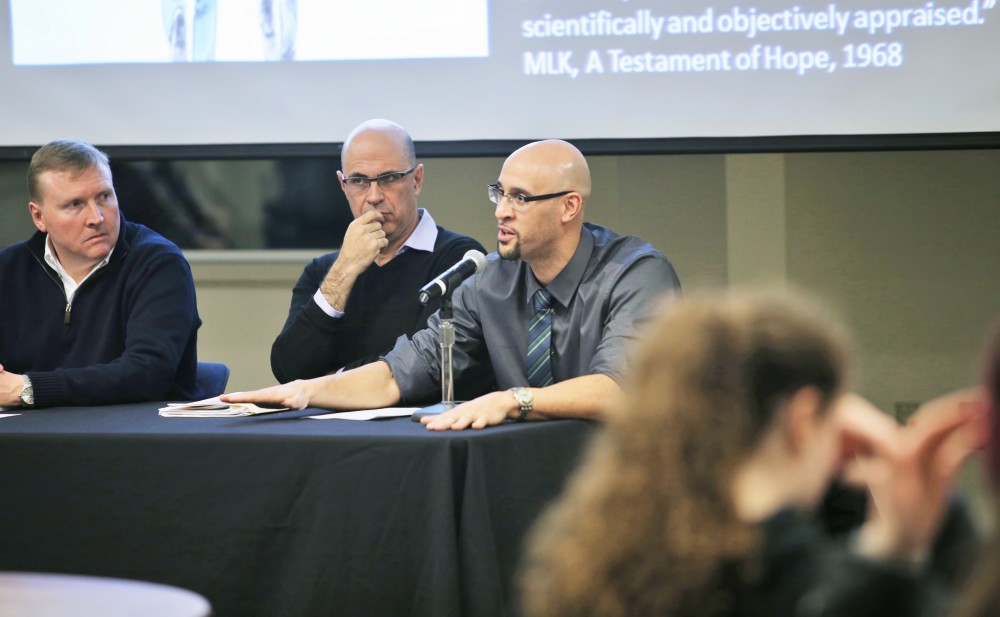Leading the way

GVL/Kevin Sielaff Louis Moore
Feb 2, 2017
Four African American college students sat down at lunch counter at a Woolworth retail store in Greensboro, North Carolina Feb. 1, 1960. Each asked for a cup of coffee – the store followed a “whites only” policy at the lunch counter. They were asked to leave; they refused to give up their seats.
Due to the lack of provocation, the attention of the local media and the support of other college students, the Greensboro Four – which was made up of Franklin McCain, Ezell Blair Jr., Joseph McNeil and David Richmond – inspired further sit-ins across the U.S. to desegregate lunch counters and other public places.
Even Grand Rapids faced civil unrest. Mirroring the race riots of Detroit and Baltimore, over 320 people were arrested in the city July 27, 1967 – most of them city residents under the age of 25.
“They (the Greensboro Four) decided to activate their act activism in order to make America great,” said Louis Moore, an associate professor of history at Grand Valley State University, specializing in African American history.
As part of his talk “Grand Rapids and Social Activism in Today’s Political Climate: Connecting the Broader Movement to the Local Experiment,” Moore addressed students, faculty and staff at the Mary Idema Pew Library at the Allendale Campus Wednesday, Feb. 1, about the Greensboro Four, the Black Lives Matter organization and other student-led movements to discuss the history of social activism in the U.S.
The rise of protests, sit-ins and boycotts within the U.S., he said, is huge on a national scale. Within West Michigan and GVSU, he said, looking at how activism affects higher education, allowing students to be part of something local and national.
Having his talk fall on the anniversary of the Greensboro sit-in and at the beginning of Black History Month, Moore said this reflects not only the impact of the celebration and the demonstration, but also demonstrates how a student’s voice can inspire change.
“In truth, going to college inspired them (the Greensboro Four) to make change and question what they have been taught,” Moore said. “They asked themselves what good is it going to college, working hard, yet still living in a Jim Crow society as second-class citizens.
“It touched the south and it touched the north and by the end of the 1960s, 70,000 students, black and white, participated in the sit-in movements.”
Discussing present social activism in the U.S., Moore also talked about U.S. Rep. John Lewis, his role in the Civil Rights Movement and his opposition to President Donald Trump’s executive order, how social media can affect protests and sit-ins and how one can become an activist in-and-out of GVSU.
Ellen Schendel, the associate dean of the Brooks College of Interdisciplinary Studies, attended the event. She asked Moore about the diverse amount of protests occurring in the U.S. happening daily – notably with the threat of repeals on healthcare and reproductive rights and the Black Rights Matter movements – and what the effect of the various demonstrations will be in the U.S.
“There’s all of these different things,” she said, “so do you think that it is a good thing in terms of an overall sort of progressive response to what is happening right now or do you think that the issues will become to diffuse because there is so many groups and things happening at once.”
In response, Moore said one cause does not demean or lessen another cause, but allows everyone to converse and work together.
“It’s just so hard because there are a lot of causes and it’s going to increase, it’s going to increase intentionally,” he said. “The next day we are going to go after reproductive rights, the next day we are going to talk about the wall, the next day we are going to talk about a ban.”
“It’s all to get people all over the place and not focus and so a lot of people will want to push back, is that you have to realize that – that this is a game being played and that we have to do it in a way that everyone will know that your problem is my problem.”





















